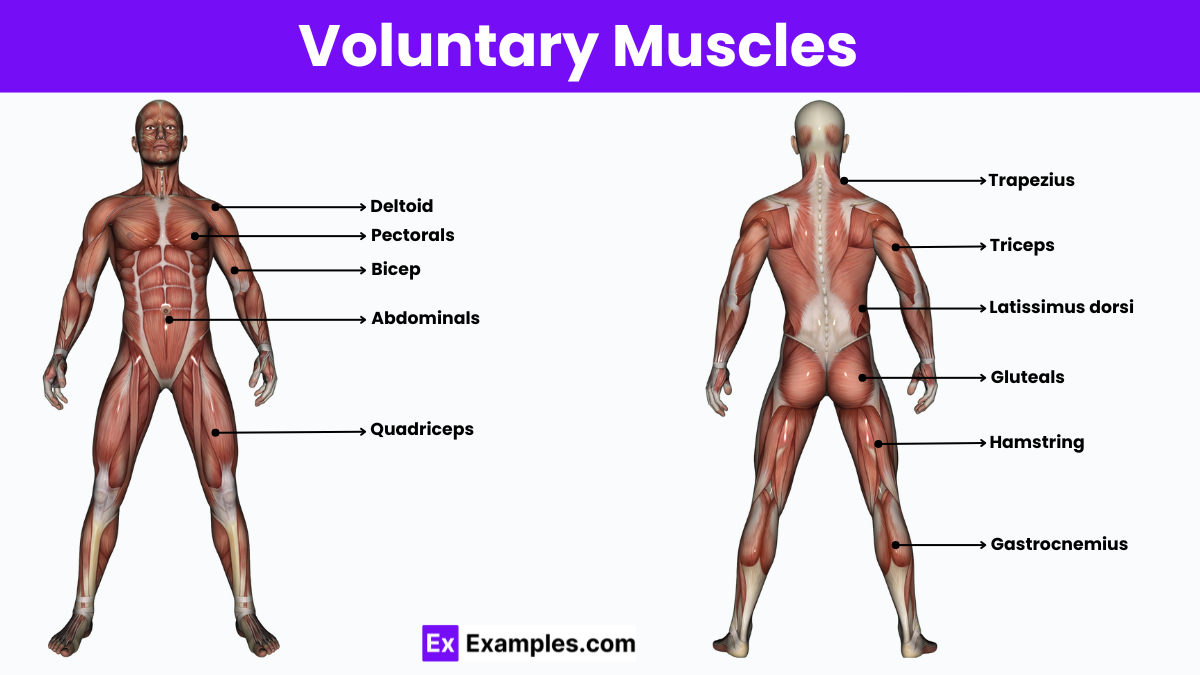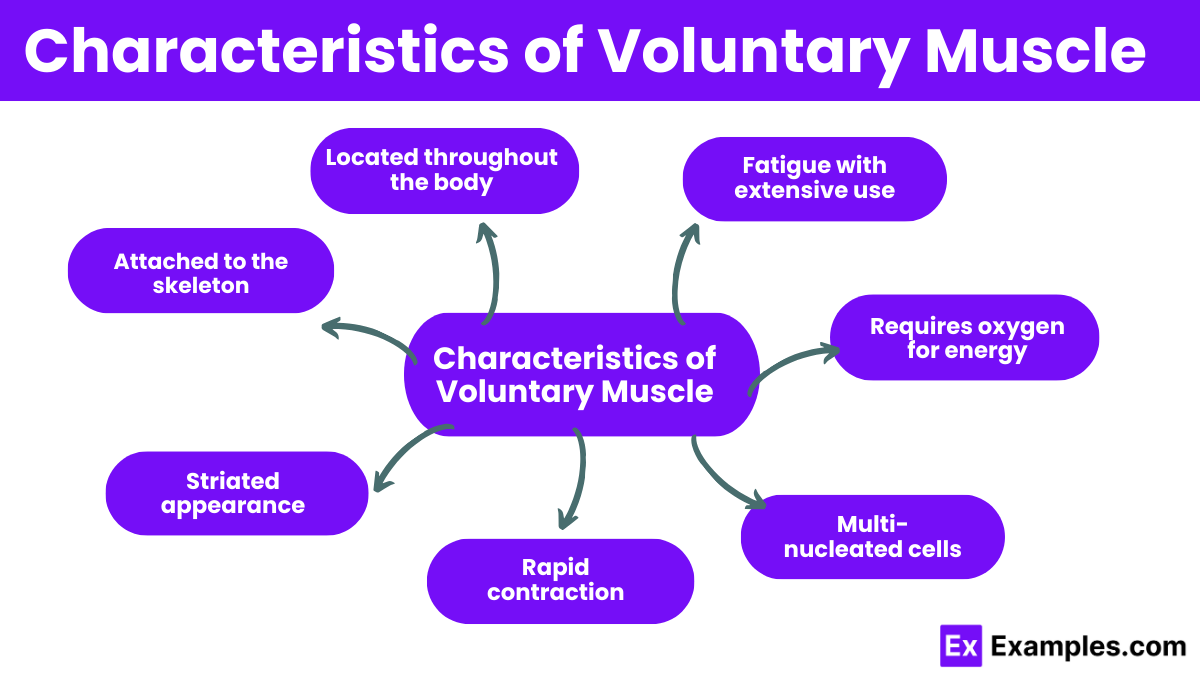Which of the following muscles is classified as a voluntary muscle?
Heart muscle
Smooth muscle
Skeletal muscle
Intestinal muscle


Voluntary muscles, or skeletal muscles, make up about 40% of body weight and contain most of the body’s proteins. These muscles facilitate voluntary movement by converting chemical energy into mechanical energy. Structurally, they consist of fascicles—bundles of muscle fibers with a striated appearance due to myofibrils composed of myosin and actin filaments. Contraction occurs when these filaments slide together, stimulated by the neurotransmitter acetylcholine. Essential skeletal muscles include the biceps, triceps, glutes, quadriceps, hamstrings, and abdominals, which control movements of the limbs and torso
Voluntary muscles, mainly made up of skeletal muscle tissue, are under a person’s direct control, allowing them to perform actions like walking and talking. These muscles have long, striped fibers that help with precise movements. Unlike the involuntary cardiac and smooth muscles in the heart and other organs, voluntary muscles connect to bones and are crucial for all movements we choose to make. Their unique structure and how we can control them are key for managing everyday activities effectively.
Located in the upper arm, the biceps flex the forearm at the elbow and rotate the forearm. These muscles are crucial for lifting and carrying objects.
These muscles are at the back of the upper arm and are essential for extending the arm at the elbow joint. You use the triceps when you push against resistance, like during a push-up.
Often called the quadriceps, these muscles are in the front of the thigh. They include four muscles that work together to extend the knee. The quadriceps are essential for standing, walking, running, and climbing.
The hamstrings are at the back of the thigh and help in bending the knee and extending the hip. These muscles are important for actions like bending the knee and moving the leg backward.
Located in the buttocks, these muscles, including the gluteus maximus, medius, and minimus, help extend and rotate the hip. They are crucial for keeping an upright posture and walking.
This group includes the rectus abdominis and the obliques. They play a major role in stabilizing the core, bending the torso, and helping with breathing.
Each of these muscle groups is critical for specific movements and overall bodily coordination. The control over these muscles is mediated through the nervous system, which sends signals to the muscles to contract when needed, allowing for precise and coordinated movements. This detailed control mechanism is what differentiates voluntary muscles from involuntary muscles, which operate without conscious control.
Voluntary muscles allow you to control your body’s movements consciously. These muscles enable you to do everyday activities like walking, grabbing objects, or talking. When you decide to move, your brain sends signals through nerves to these muscles, telling them to contract or relax. This control makes it possible to perform precise and coordinated actions.
Voluntary muscles also play a key role in maintaining posture and stabilizing your joints. For instance, they keep your spine aligned and help hold your body upright when you stand or sit. Additionally, these muscles generate heat as they work, which helps maintain your body temperature.
By managing how these muscles contract, you can perform complex movements like playing a musical instrument or typing on a keyboard, showcasing their importance in daily life and skilled activities.

Voluntary muscles, critical components of the human body, are commonly referred to as skeletal muscles. This designation highlights their primary role in connecting to the skeleton and facilitating movement. Unlike involuntary muscles, which operate automatically without conscious control (such as those found in the heart and digestive system), voluntary muscles are under our conscious command. This means that any movement we decide to make, like walking, talking, or typing, involves the activation of these muscles.
Voluntary muscles are primarily located throughout the body where conscious movement is required. They are predominant in areas such as the arms, legs, back, and face. For instance:
Biceps, triceps, quadriceps, hamstrings, and deltoids are common examples of voluntary muscles.
An involuntary muscle operates automatically without conscious control, like the heart muscle.
The three types of muscle cells that are voluntary include skeletal muscle fibers found in arms and legs.
Skeletal muscles are voluntary, allowing controlled movements like walking or lifting.
The diaphragm is unique as it functions both as a voluntary and involuntary muscle, supporting breathing.
Text prompt
Add Tone
10 Examples of Public speaking
20 Examples of Gas lighting
Which of the following muscles is classified as a voluntary muscle?
Heart muscle
Smooth muscle
Skeletal muscle
Intestinal muscle
Voluntary muscles are primarily controlled by which system?
Digestive system
Respiratory system
Nervous system
Endocrine system
What is the primary function of voluntary muscles?
Pump blood
Digest food
Facilitate movement
Regulate hormones
Which type of muscle fiber is found in voluntary muscles?
Cardiac fibers
Smooth fibers
Striated fibers
Myocardial fibers
Which of the following is an example of a voluntary muscle action?
Heartbeat
Blinking
Breathing
Running
Voluntary muscles attach to bones via:
Ligaments
Cartilage
Tendons
Joints
Which of the following is NOT a characteristic of voluntary muscles?
Under conscious control
Striated appearance
Involuntary contractions
Attached to the skeleton
Which muscle type is responsible for facial expressions?
Cardiac muscle
Smooth muscle
Skeletal muscle
Involuntary muscle
What is the role of motor neurons in voluntary muscle function?
Stimulate involuntary muscles
Transmit signals from the brain to the muscles
Regulate hormone release
Digest food
Which muscle action is considered voluntary?
Peristalsis in the intestines
Heartbeat
Lifting an arm
Vasoconstriction
Before you leave, take our quick quiz to enhance your learning!

